How to Adapt Yoga Poses for Different Pet Sizes
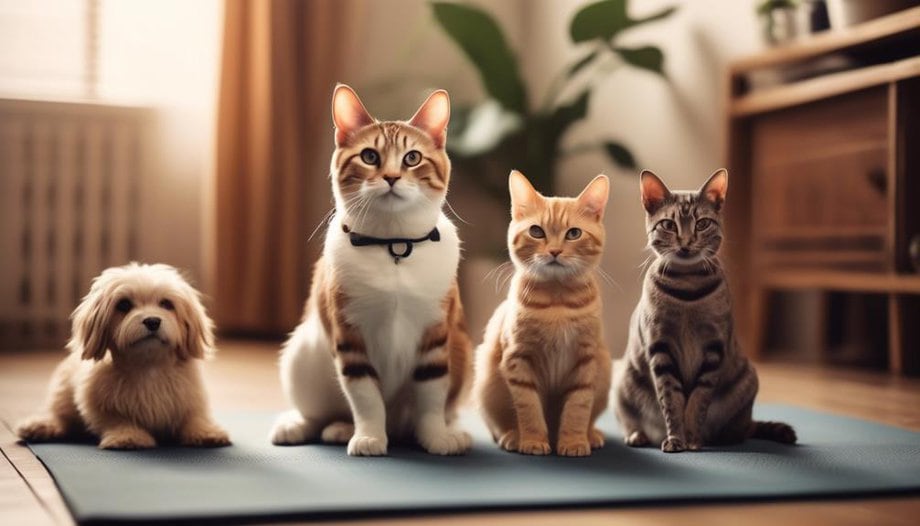
When it comes to practicing yoga with your pets, it's important to consider their size and physical capabilities. Here are some tips for adapting yoga poses for different pet sizes:
For small pets, such as cats or small dogs, it's best to focus on gentle stretches and poses that don't put too much strain on their joints. You can try poses like the cat-cow stretch, where they arch their back up and then drop it down, or the seated forward fold, where they stretch out their spine and hamstrings.
For medium-sized pets, like medium-sized dogs, you can incorporate some more dynamic movements into their yoga practice. Poses like the downward-facing dog or the warrior pose can help them build strength and flexibility. Just make sure to provide them with enough space to move around comfortably.
For larger pets, like big dogs, it's important to focus on poses that support their size and provide stability. Poses like the mountain pose or the chair pose can help them build strength in their legs and core. You can also try using props, such as a sturdy blanket or pillow, to provide additional support during certain poses.
Remember to always be mindful of your pet's comfort and never force them into any poses. If they seem uncomfortable or resistant, it's best to modify or skip the pose altogether. And of course, always consult with your veterinarian before starting any new exercise routine with your pet.
By adapting yoga poses to suit your pet's size and physical abilities, you can create a safe and enjoyable yoga practice for both you and your furry friend. So go ahead and get on the mat together, and enjoy the benefits of practicing yoga with your pet.
Key Takeaways
- Gentle stretches and poses that do not strain the pet's joints are important for all pet sizes in yoga practice.
- Modifying poses to accommodate the pet's size and physical limitations is crucial for their comfort and safety.
- Consulting with a veterinarian before starting a new yoga routine for pets is essential.
- Props and modifications such as tables, blankets, and blocks can provide additional support and stability for medium and large pets during yoga poses.
Assessing Your Pet's Size and Abilities
When assessing your pet's size and abilities for adapting yoga poses, it's important to consider their unique physical characteristics and limitations. Understanding these factors will allow you to modify poses accordingly, ensuring that your furry friend can fully participate in the practice.
Assessing the size of your pet is the first step in determining which yoga poses are suitable for them. Larger pets may struggle with poses that require a significant amount of balance or flexibility, while smaller pets may have difficulty with poses that require strength or endurance. By evaluating their size limitations, you can choose poses that are appropriate and safe for them to attempt.
In addition to size, it's crucial to consider any disabilities or limitations that your pet may have. Just like humans, pets can experience physical challenges that may require modifications to the poses. For example, if your pet has limited mobility or joint issues, you can adapt the poses by using props or adjusting the intensity of the movements. By modifying poses for disabled pets, you can ensure that they can still enjoy the benefits of yoga while minimizing any potential discomfort or risk of injury.
Modifying Standing Poses for Small Pets
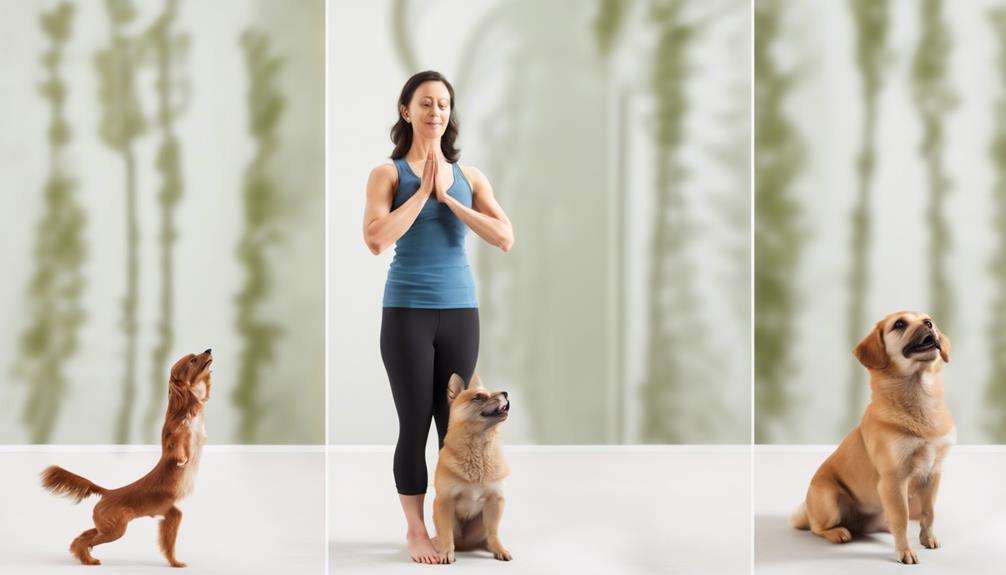
When modifying standing poses for small pets, there are a few size considerations to keep in mind.
For example, a small dog may not have the same range of motion as a larger dog, so adjustments may need to be made to accommodate their size and mobility.
It's important to ensure that the poses are safe and comfortable for the pet, so modifications should be made accordingly.
Size Considerations
To accommodate small pets during standing poses, practitioners can make simple adjustments to ensure their comfort and safety. Assessing the flexibility and accommodating the joint limitations of small pets are crucial steps in modifying standing poses for them. By understanding their physical limitations, practitioners can tailor the poses to suit their needs.
Here is a table that provides guidance on how to modify standing poses for small pets:
| Pose | Original Position | Modified Position |
|---|---|---|
| Mountain Pose | Standing with paws together | Standing with paws slightly apart |
| Warrior I | Standing with legs wide apart and arms extended | Standing with legs closer together and arms slightly bent |
| Tree Pose | Balancing on one leg with the other leg lifted and foot resting on the inner thigh | Balancing on one leg with the other leg bent and foot resting on the lower leg |
| Triangle Pose | Standing with legs wide apart and one arm reaching towards the floor and the other arm extended upwards | Standing with legs closer together and both arms extended upwards |
Adjusting for Mobility
After addressing the size considerations for small pets, practitioners can now focus on adjusting standing poses to accommodate their mobility. Modifying poses is vital to ensure that small pets with limited mobility can still benefit from yoga.
When it comes to accommodating limitations, it's essential to consider the specific needs of each individual pet. For small pets, standing poses can be challenging due to their size and physical restrictions.
To make these poses accessible, practitioners can lower the height of the pose or provide additional support by using props such as blankets or blocks. This allows small pets to maintain balance and stability while performing the pose.
Adapting Seated Poses for Large Pets
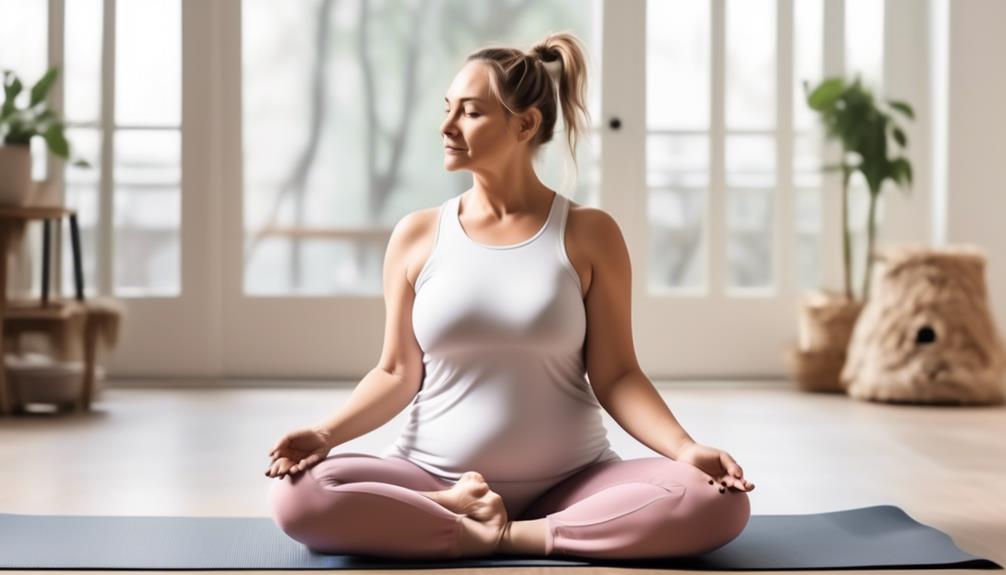
Large pets require special adaptations for seated yoga poses to ensure their comfort and safety. Adapting reclining poses and modifying forward bends can help accommodate the size and physicality of these pets.
When it comes to seated poses, it's important to consider the space needed for large pets to comfortably sit. For reclining poses, such as the reclining bound angle pose, a large pet may require a wider base of support. This can be achieved by using additional props, such as blankets or bolsters, to create a comfortable and stable surface for the pet to rest on.
Modifying forward bends for large pets involves providing enough space for them to stretch and extend their body. For example, in the seated forward fold, a large pet may need a wider stance to accommodate their size. This can be achieved by placing their front paws or legs wider apart. Additionally, using props, such as blocks or cushions, can help support the pet's body and allow for a deeper stretch.
It's important to remember that every pet is unique, and their adaptations may vary depending on their size, mobility, and comfort level. Always observe and listen to your pet's cues during yoga practice, and make adjustments as necessary to ensure their comfort and safety.
Adjusting Twisting Poses for Medium-Sized Pets
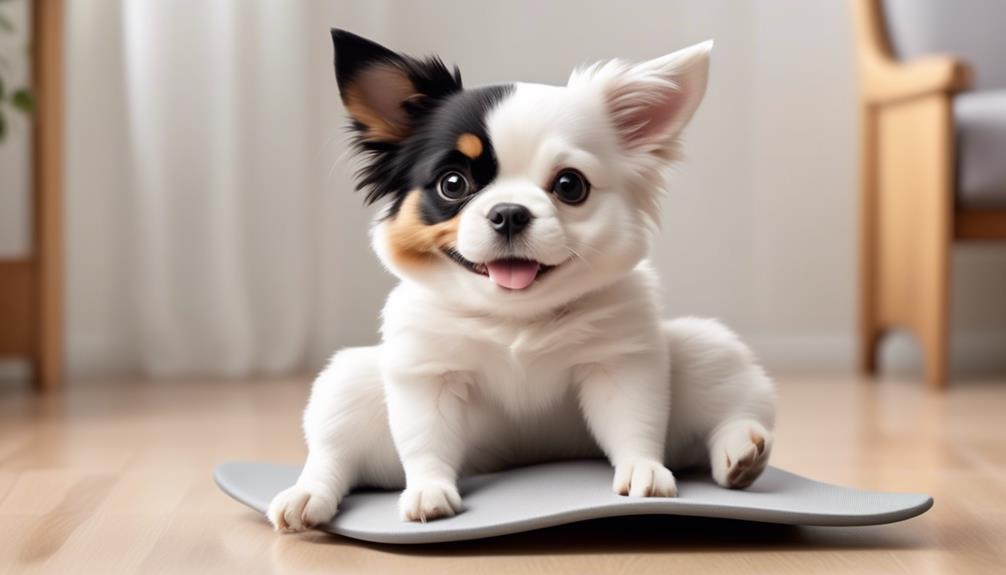
When it comes to practicing yoga with medium-sized pets, it's important to make modifications to twisting poses to ensure their safety and comfort.
Twisting poses can be beneficial for pets as they help to stretch their muscles and improve flexibility.
However, it's crucial to adapt these poses by using props or adjusting the angle to accommodate their size and physical capabilities.
Modification for Medium-Sized Pets
For medium-sized pets, adjusting twisting poses can provide a beneficial and comfortable yoga experience. These modifications focus on maintaining balance and improving flexibility.
Here are three ways to adapt twisting poses for medium-sized pets:
- Balance modifications: Medium-sized pets may struggle with maintaining balance in certain twisting poses. To help them stay steady, use props such as yoga blocks or blankets to provide additional support. Placing the props strategically can help distribute the weight and allow the pet to find their center.
- Flexibility adjustments: Some medium-sized pets may have limited flexibility, especially in their spines. To accommodate this, gently guide them into the twisting pose, using your hands to provide support and ensure they don't overextend. Gradually increase the range of motion as their flexibility improves over time.
Remember to always listen to your pet's cues and adjust the poses accordingly. By making these modifications, you can ensure a safe and enjoyable yoga practice for your medium-sized furry friend.
Twisting Poses for Medium Pets
Adjusting twisting poses for medium-sized pets can help improve their balance, flexibility, and overall yoga experience. Twisting poses are beneficial for pets as they stretch and strengthen their muscles, promote digestion, and release tension. For medium-sized pets, modifications may be necessary to ensure their safety and comfort during these poses.
When performing twisting poses for large pets, it's important to consider their size and strength. It's recommended to provide additional support and stability by using props like blankets or blocks.
On the other hand, when adapting twisting poses for small pets, it's crucial to be gentle and mindful of their delicate frames. Modifying the poses to be less intense and ensuring proper alignment can prevent any strain or injury.
Adapting Twists for Pets
To ensure the safety and comfort of medium-sized pets, modifications can be made to twisting poses, allowing them to benefit from improved balance, flexibility, and overall yoga experience. Adapting hip openers and modifying arm balances can help these pets engage in twisting poses effectively.
Here are three ways to adapt twists for medium-sized pets:
- Adjust the intensity: For pets with limited flexibility, start with gentle twists and gradually increase the depth of the pose as they become more comfortable. This will prevent any strain or discomfort.
- Use props: Props such as blankets or blocks can provide additional support during twisting poses. Placing them strategically can help pets find stability and maintain proper alignment.
- Focus on breath: Encourage pets to take slow, deep breaths while in a twist. This won't only enhance their relaxation but also promote a deeper stretch.
Tailoring Inversions for Extra-Large Pets
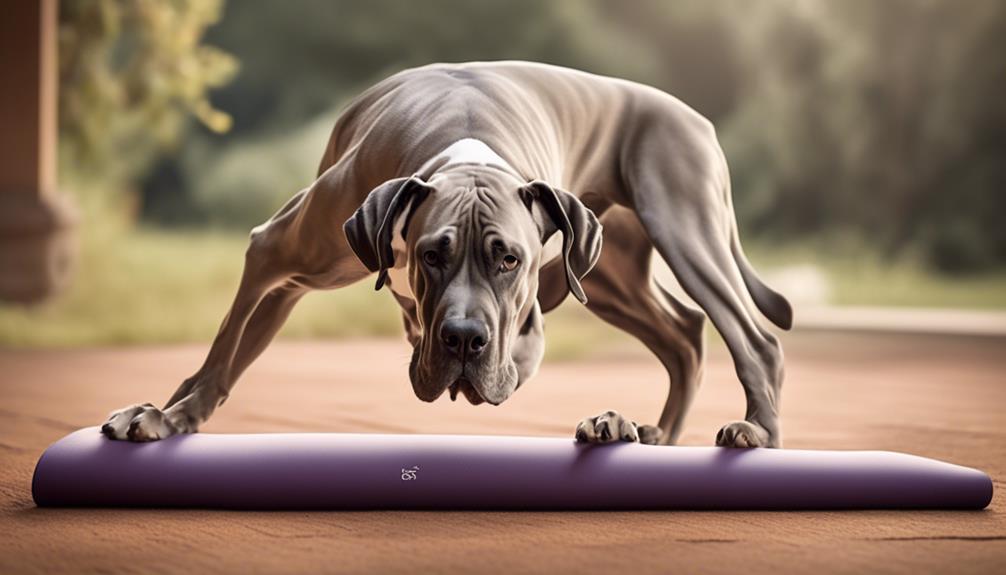
When working with extra-large pets, modifying inversions in yoga poses can ensure their comfort and safety throughout the practice. Just as adapting inversions for small pets requires special attention, so does tailoring them for extra-large pets.
Inversions are beneficial for pets of all sizes as they help improve circulation, relieve stress, and promote mental and physical balance. However, it's important to make adjustments to accommodate the unique needs of larger pets.
For extra-large pets, such as Great Danes or Saint Bernards, modifying forward folds is key. These gentle inversions can be challenging for larger pets due to their size and weight. To modify forward folds for extra-large pets, it's recommended to use props like bolsters or blocks to provide additional support. Placing these props strategically can help elevate their front or hindquarters, making it easier for them to maintain balance and engage in the pose.
When practicing inversions with extra-large pets, it's crucial to always monitor their comfort and safety. Keep a close eye on their body language and be ready to make further modifications if necessary.
Making Backbends Accessible for Tiny Pets
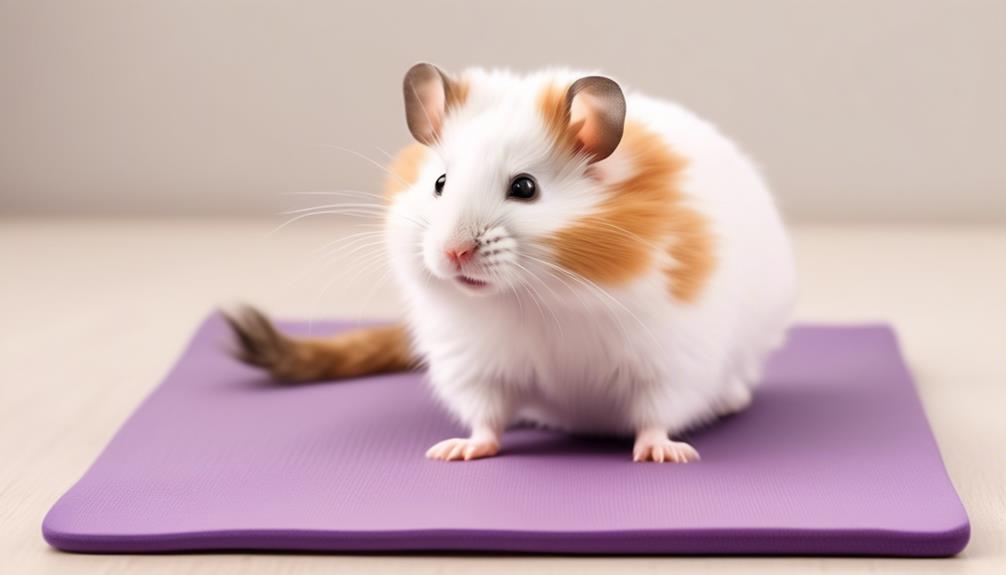
Taking into consideration the unique needs of large pets, adapting inversions in yoga poses can ensure their safety and well-being throughout their practice. Here are three ways to make inversions accessible for large pets:
- Use sturdy props: When practicing inversions with large pets, it's important to provide them with stable props that can support their weight. Using a sturdy chair or wall can help them feel secure and prevent any accidents or injuries.
- Modify the pose: Instead of traditional inversions like headstand or shoulderstand, opt for modified versions that are more suitable for large pets. For example, you can encourage them to do a supported bridge pose or a downward-facing dog with their front paws on an elevated surface.
- Offer hands-on support: During inversions, it's crucial to provide hands-on support to your large pet to ensure their safety. You can gently hold their hind legs or hips to help them maintain balance and prevent any strain on their neck or spine.
Customizing Forward Folds for Different Pet Sizes
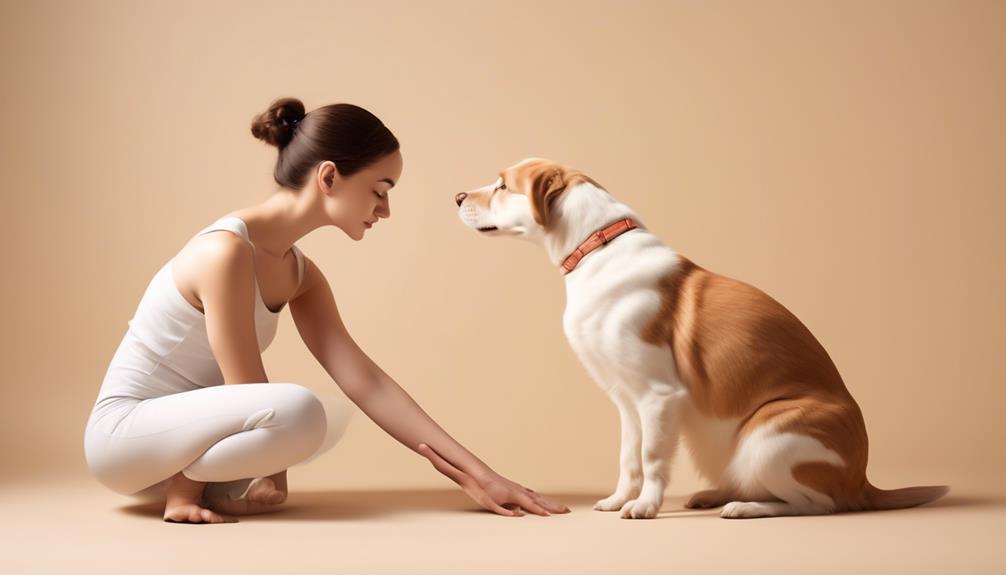
Customizing forward folds for different pet sizes requires careful consideration and adjustments to ensure their comfort and safety during the practice. Just like humans, pets come in all shapes and sizes, and it's important to adapt yoga poses to accommodate their individual needs. When it comes to forward folds, it's essential to customize the pose to suit the size and physical abilities of your furry friend.
For small pets, use a folded blanket or pillow to elevate their front paws and support their chest. Keep the forward fold gentle and shallow, ensuring their spine remains straight and supported. Avoid excessive pressure on their neck and shoulders by keeping their head elevated. Ensure they have enough space to comfortably stretch their legs forward without restriction. Always monitor their breathing and adjust the pose if they show signs of discomfort or distress.
For medium pets, place a bolster or cushion under their chest to provide extra support and comfort. Encourage a deeper fold, but always monitor their comfort level and make adjustments as necessary. Support their neck and shoulders with a folded blanket or cushion to prevent strain or discomfort. Allow for adequate leg room and support their hips with props if needed. Observe their breathing and adjust the pose accordingly, ensuring their comfort throughout the practice.
For large pets, consider using multiple bolsters or cushions to ensure proper alignment and support for their larger body. Allow for a deeper fold, but be mindful of their size and any potential strain on their joints or muscles. Provide additional support for their neck and shoulders with props, such as blankets or yoga blocks. Provide ample space for their larger body and use props to support their hips, if necessary. Continuously monitor their breathing and make necessary modifications to maintain their comfort and safety.
Frequently Asked Questions
Can I Practice Yoga With My Pet if They Have Physical Limitations or Disabilities?
Pets with physical limitations or disabilities can still practice yoga with their owners. Adapting poses for their unique needs is essential. The benefits of practicing yoga together include improved mobility, increased bonding, and a sense of calmness and relaxation for both pet and owner.
How Can I Modify Yoga Poses for Pets With Long Bodies, Like Dachshunds or Corgis?
When adapting yoga poses for pets with long bodies, like dachshunds or corgis, modifications can be made to accommodate their unique physique. These modifications can provide numerous benefits and can be easily incorporated into their daily routines.
Is It Safe to Practice Inversions With My Large Dog if They Have Joint Issues or a History of Back Problems?
It's important to prioritize your large dog's safety when practicing inversions, especially if they have joint issues or a history of back problems. Consult with a veterinary professional before attempting any poses.
Are There Any Specific Precautions or Modifications I Should Take When Practicing Yoga With Small Pets Like Rabbits or Guinea Pigs?
When practicing yoga with small pets like rabbits or guinea pigs, it's important to take precautions and modify the poses accordingly. This ensures their safety and well-being. Here's how to adapt yoga poses for small pets.
Can I Practice Yoga With My Pet if They Are Older and Less Flexible?
If your furry friend is getting up there in years and finding it harder to touch their toes, fear not! You can still practice yoga together. Just make a few modifications and enjoy the benefits of a flexible bonding session.









